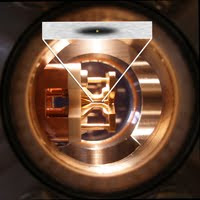Ads : Nano Technology Netbook Technology News Computer Software
The successful creation of this hybrid system opens the way to new types of experiment, in which the precise controllability of trapped ions can be used to study and manipulate quantum gases with nanometre precision.
In recent years, the ultracold quantum gases known as Bose-Einstein condensates and single ions confined in electromagnetic traps have both been used to explore a wide range of problems in fundamental physics.
Writing in this week’s Nature, the team from the Department of Physics at the University of Cambridge describe the immersion of a single trapped ytterbium ion in a Bose-Einstein condensate of neutral rubidium atoms.
They showed that they can control the two systems independently, and study their interactions. They also observe ‘sympathetic cooling’ of the ion by the condensate – an effect that might ultimately prove useful in quantum computing.
According to Dr Michael Köhl: “We placed a single charged Ytterbium atom into a Bose-Einstein condensate, which at only a few billionths of a degree above absolute zero is the coldest thing in the universe.”
The results could be used to cool quantum computers – devices that, by employing the laws of quantum mechanics, can solve certain computational tasks much faster than any existing computer. Basic quantum processors already exist but they are not yet surpassing the fastest normal computers.
“Today’s most powerful quantum computers are made from single atoms, like our Ytterbium, trapped in vacuum, but they need to be refrigerated in order to compute correctly. Usually this is done with laser light, which is quite complicated, expensive, and it interrupts the computing process. With our new technique, quantum computers could be cooled continuously in the future which could pave the way to a more widespread application,” says Dr Köhl.
The picture shows the team’s experimental apparatus comprising of the ion trap inside the vacuum chamber. The inset shows schematically the single ion (red) in the Bose-Einstein condensate (dark grey).
Nature – A trapped single ion inside a Bose–Einstein condensate
Improved control of the motional and internal quantum states of ultracold neutral atoms and ions has opened intriguing possibilities for quantum simulation and quantum computation. Many-body effects have been explored with hundreds of thousands of quantum-degenerate neutral atoms1, and coherent light–matter interfaces have been built. Systems of single or a few trapped ions have been used to demonstrate universal quantum computing algorithms and to search for variations of fundamental constants in precision atomic clocks. Until now, atomic quantum gases and single trapped ions have been treated separately in experiments. Here we investigate whether they can be advantageously combined into one hybrid system, by exploring the immersion of a single trapped ion into a Bose–Einstein condensate of neutral atoms. We demonstrate independent control over the two components of the hybrid system, study the fundamental interaction processes and observe sympathetic cooling of the single ion by the condensate. Our experiment calls for further research into the possibility of using this technique for the continuous cooling of quantum computers. We also anticipate that it will lead to explorations of entanglement in hybrid quantum systems and to fundamental studies of the decoherence of a single, locally controlled impurity particle coupled to a quantum environment
Editor’s Summary – A Bose–Einstein trap
Until now, quantum atomic gases and single trapped ions have been treated separately in experiments. Now a team from the Cavendish Laboratory in Cambridge has combined the two, in the form of a hybrid quantum system composed of a Bose–Einstein condensate of neutral atoms and a trapped atomic ion. They achieve independent control over the two systems, study the fundamental interaction processes and observe sympathetic cooling of the single ion by the condensate. Possible avenues of research that this could lead to include the continuous cooling of quantum computers, and explorations of entanglement in hybrid quantum systems.
Advertising
Trading Futures
Nano Technology
Netbook Technology News
Computer Software
Future Predictions
Thank You

Brian Wang is a Futurist Thought Leader and a popular Science blogger with 1 million readers per month. His blog Nextbigfuture.com is ranked #1 Science News Blog. It covers many disruptive technology and trends including Space, Robotics, Artificial Intelligence, Medicine, Anti-aging Biotechnology, and Nanotechnology.
Known for identifying cutting edge technologies, he is currently a Co-Founder of a startup and fundraiser for high potential early-stage companies. He is the Head of Research for Allocations for deep technology investments and an Angel Investor at Space Angels.
A frequent speaker at corporations, he has been a TEDx speaker, a Singularity University speaker and guest at numerous interviews for radio and podcasts. He is open to public speaking and advising engagements.


